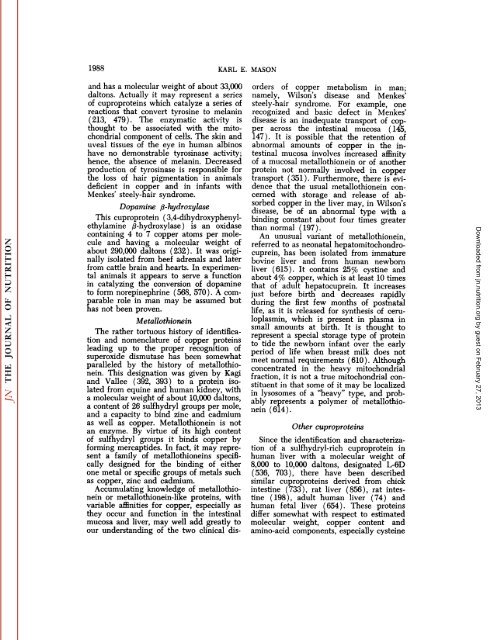conspectus of researchon copper metabolism and requirements
conspectus of researchon copper metabolism and requirements
conspectus of researchon copper metabolism and requirements
Create successful ePaper yourself
Turn your PDF publications into a flip-book with our unique Google optimized e-Paper software.
1988 KARL E. MASON<br />
<strong>and</strong> has a molecular weight <strong>of</strong> about 33,000<br />
daltons. Actually it may represent a series<br />
<strong>of</strong> cuproproteins which catalyze a series <strong>of</strong><br />
reactions that convert tyrosine to melanin<br />
(213, 479). The enzymatic activity is<br />
thought to be associated with the mitochondrial<br />
component <strong>of</strong> cells. The skin <strong>and</strong><br />
uveal tissues <strong>of</strong> the eye in human albinos<br />
have no demonstrable tyresinase activity;<br />
hence, the absence <strong>of</strong> melanin. Decreased<br />
production <strong>of</strong> tyrosinase is responsible for<br />
the loss <strong>of</strong> hair pigmentation in animals<br />
deficient in <strong>copper</strong> <strong>and</strong> in infants with<br />
Menkes' steely-hair syndrome.<br />
Dopamine ß-hijdroxylase<br />
This cuproprotein (3,4-dihydroxyphenylethylamine<br />
ß-hydroxylase) is an oxidase<br />
containing 4 to 7 <strong>copper</strong> atoms per mole<br />
cule <strong>and</strong> having a molecular weight <strong>of</strong><br />
about 290,000 daltons (232). It was origi<br />
nally isolated from beef adrenals <strong>and</strong> later<br />
from cattle brain <strong>and</strong> hearts. In experimen<br />
tal animals it appears to serve a function<br />
in catalyzing the conversion <strong>of</strong> dopamine<br />
to form norepinephrine (568, 570). A com<br />
parable role in man may be assumed but<br />
has not been proven.<br />
Metallothionein<br />
The rather tortuous history <strong>of</strong> identifica<br />
tion <strong>and</strong> nomenclature <strong>of</strong> <strong>copper</strong> proteins<br />
leading up to the proper recognition <strong>of</strong><br />
Superoxide dismutase has been somewhat<br />
paralleled by the history <strong>of</strong> metallothionein.<br />
This designation was given by Kagi<br />
<strong>and</strong> Vallee (392, 393) to a protein iso<br />
lated from equine <strong>and</strong> human kidney, with<br />
a molecular weight <strong>of</strong> about 10,000 daltons,<br />
a content <strong>of</strong> 26 sulfhydryl groups per mole,<br />
<strong>and</strong> a capacity to bind zinc <strong>and</strong> cadmium<br />
as well as <strong>copper</strong>. Metallothionein is not<br />
an enzyme. By virtue <strong>of</strong> its high content<br />
<strong>of</strong> sulfhydryl groups it binds <strong>copper</strong> by<br />
forming mercaptides. In fact, it may repre<br />
sent a family <strong>of</strong> metallothioneins specifi<br />
cally designed for the binding <strong>of</strong> either<br />
one metal or specific groups <strong>of</strong> metals such<br />
as <strong>copper</strong>, zinc <strong>and</strong> cadmium.<br />
Accumulating knowledge <strong>of</strong> metallothionein<br />
or metallothionein-like proteins, with<br />
variable affinities for <strong>copper</strong>, especially as<br />
they occur <strong>and</strong> function in the intestinal<br />
mucosa <strong>and</strong> liver, may well add greatly to<br />
our underst<strong>and</strong>ing <strong>of</strong> the two clinical dis<br />
orders <strong>of</strong> <strong>copper</strong> <strong>metabolism</strong> in man;<br />
namely, Wilson's disease <strong>and</strong> Menkes'<br />
steely-hair syndrome. For example, one<br />
recognized <strong>and</strong> basic defect in Menkes'<br />
disease is an inadequate transport <strong>of</strong> cop<br />
per across the intestinal mucosa (145,<br />
147). It is possible that the retention <strong>of</strong><br />
abnormal amounts <strong>of</strong> <strong>copper</strong> in the in<br />
testinal mucosa involves increased affinity<br />
<strong>of</strong> a mucosal metallothionein or <strong>of</strong> another<br />
protein not normally involved in <strong>copper</strong><br />
transport (351). Furthermore, there is evi<br />
dence that the usual metallothionein con<br />
cerned with storage <strong>and</strong> release <strong>of</strong> ab<br />
sorbed <strong>copper</strong> in the liver may, in Wilson's<br />
disease, be <strong>of</strong> an abnormal type with a<br />
binding constant about four times greater<br />
than normal ( 197).<br />
An unusual variant <strong>of</strong> metallothionein,<br />
referred to as neonatal hepatomitochondrocuprein,<br />
has been isolated from immature<br />
bovine liver <strong>and</strong> from human newborn<br />
liver (615). It contains 25% cystine <strong>and</strong><br />
about 49¿<strong>copper</strong>, which is at least 10 times<br />
that <strong>of</strong> adult hepatocuprein. It increases<br />
just before birth <strong>and</strong> decreases rapidly<br />
during the first few months <strong>of</strong> postnatal<br />
life, as it is released for synthesis <strong>of</strong> ceruloplasmin,<br />
which is present in plasma in<br />
small amounts at birth. It is thought to<br />
represent a special storage type <strong>of</strong> protein<br />
to tide the newborn infant over the early<br />
period <strong>of</strong> life when breast milk does not<br />
meet normal <strong>requirements</strong> (610 ). Although<br />
concentrated in the heavy mitochondrial<br />
fraction, it is not a true mitochondrial con<br />
stituent in that some <strong>of</strong> it may be localized<br />
in lysosomes <strong>of</strong> a "heavy" type, <strong>and</strong> prob<br />
ably represents a polymer <strong>of</strong> metallothio<br />
nein (614).<br />
Other cuproproteins<br />
Since the identification <strong>and</strong> characteriza<br />
tion <strong>of</strong> a sulfhydryl-rich cuproprotein in<br />
human liver with a molecular weight <strong>of</strong><br />
8,000 to 10,000 daltons, designated L-6D<br />
(536, 703), there have been described<br />
similar cuproproteins derived from chick<br />
intesane (733), rat liver (856), rat intes<br />
tine ( 198), adult human liver ( 74 ) <strong>and</strong><br />
human fetal liver (654). These proteins<br />
differ somewhat with respect to estimated<br />
molecular weight, <strong>copper</strong> content <strong>and</strong><br />
amino-acid components, especially cysteine<br />
Downloaded from<br />
jn.nutrition.org<br />
by guest on February 27, 2013
















